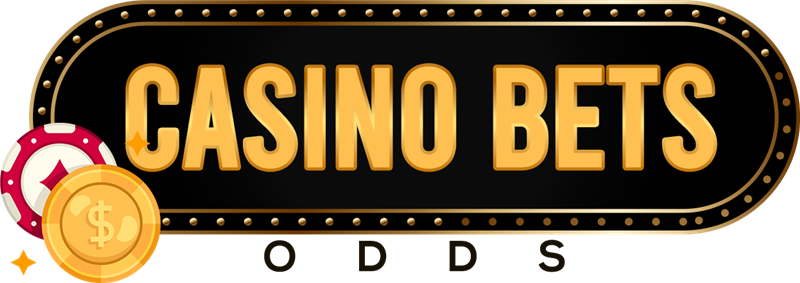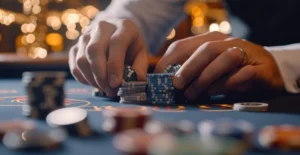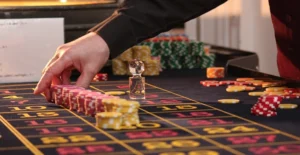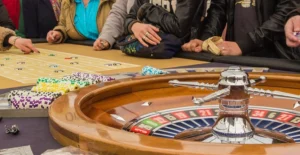So, you’ve heard about Face Up Pai Gow Poker, right? It’s a spin on the classic Pai Gow game, but with a pretty big difference that changes things up. If you’re wondering how to play face-up pai gow poker, you’re in the right spot. The main thing that sets it apart is that the dealer’s cards are shown right from the start, which gives you a bit of an edge. It’s a fun casino game, and we’ll walk you through the basics so you can get started.
Key Takeaways
- Face Up Pai Gow Poker is like regular Pai Gow, but the dealer’s hand is visible right away.
- The game uses a 53-card deck, which includes a standard 52-card deck and one joker.
- Your main goal is to create two poker hands from the seven cards you’re dealt: a five-card hand and a two-card hand.
- It’s super important that your five-card hand is stronger than your two-card hand, always.
- After setting your hands, you compare them to the dealer’s to see if you win, lose, or push (tie).
1.Introduction to Face Up Pai Gow Poker
Face Up Pai Gow Poker is a cool twist on the classic game. If you’re familiar with regular Pai Gow, you’ll pick this up pretty quickly, but there are some key differences that make it unique. The biggest one? The dealer’s hand is face up from the start. This changes everything about how you strategize and play your own hand. It’s a head-to-head game against the dealer, and there are often side bets like the Fortune Bonus or Ace-High to spice things up.
Face Up Pai Gow Poker uses a 53-card deck (standard 52 plus a joker). The Joker isn’t a wild card in the traditional sense; it usually acts as an Ace or can be used to complete straights or flushes. The game is played on a table that seats up to six players and a player-dealer. Each player has spots for their main bet, Fortune Bonus, and Ace-High Bonus bets.
Here’s what makes it stand out:
- The dealer’s hand is visible.
- Often includes side bets.
- Uses a 53-card deck with a specific joker rule.
If you’re looking for casino news to improve your playing skills, keep reading!
2.Deck Composition & the Joker in Pai Gow Poker
Pai Gow Poker uses a standard 52-card deck, but with a twist – it includes one joker. This joker adds an interesting element to the game, influencing hand possibilities and strategies. Understanding how the Joker functions is key to mastering Pai Gow Poker.
The Joker’s primary role is to act as a wild card, but with limitations. It can be used as an ace, which is often its most common function. However, the Joker’s real value shines when it can complete a straight or a flush. If you can use it to form either of those hands, that’s usually the best play. If not, it defaults to being an ace.
Think of it this way:
- As an Ace: If it doesn’t help make a straight or flush, it’s an ace.
- Completing Straights/Flushes: This is where the joker is most valuable.
The Joker rule can feel a little restrictive at first, but it’s what makes Pai Gow Poker unique. It forces you to think strategically about how to arrange your hands, and it can sometimes lead to unexpected outcomes.
Knowing the deck and the joker’s role is the first step. Next, you’ll need to understand the objective: setting your hands to beat the banker. Remember, you’re making two poker hands, so it’s not just about getting one strong hand, but two that work together.
3.Objective: Setting High and Low Hands in Poker
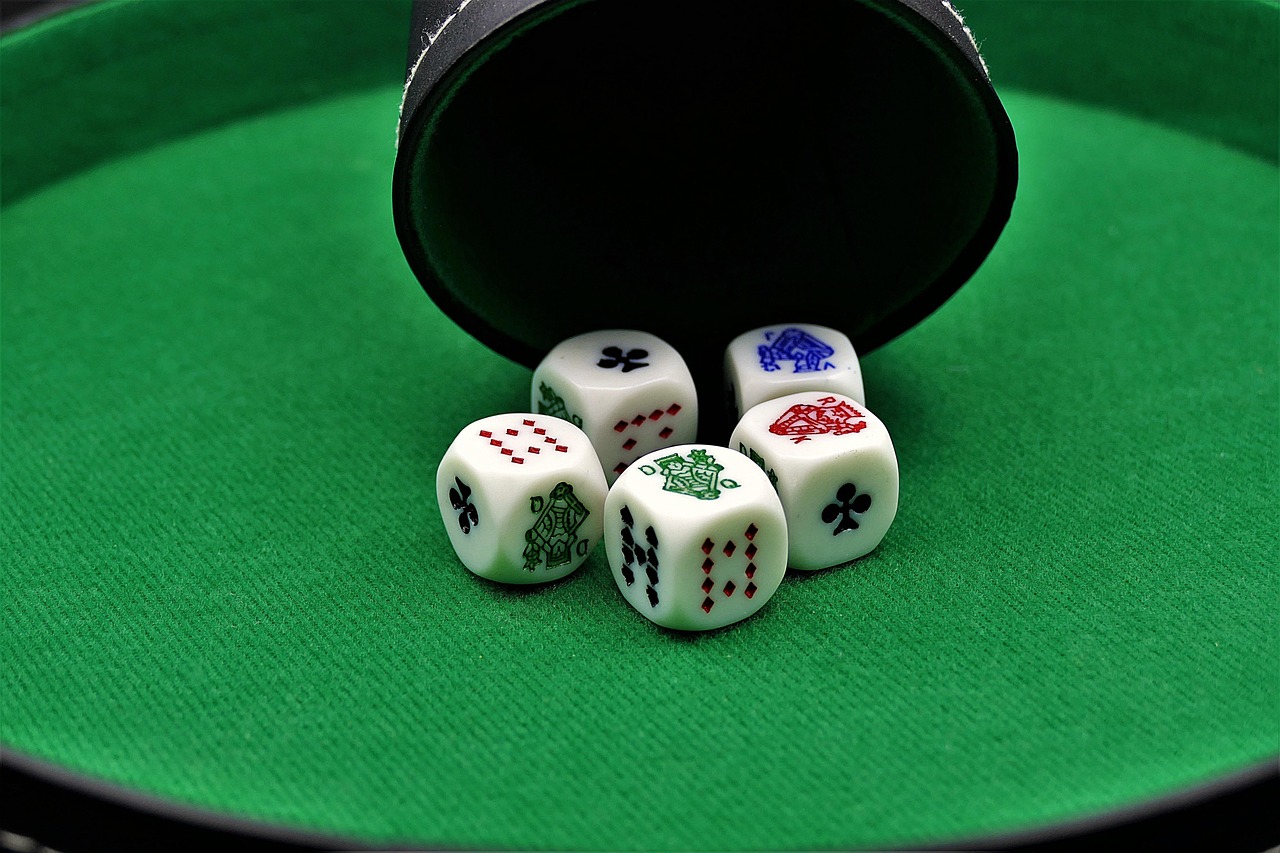
The main goal in Face Up Pai Gow Poker is to arrange your seven cards into two hands: a five-card hand (the “high” hand) and a two-card hand (the “low” hand). Both of your hands need to outrank the dealer’s corresponding hands for you to win the bet. If you win one hand and the dealer wins the other, it’s a push, and no money changes hands. If both hands tie, the dealer wins, which is a standard Pai Gow Poker rule.
- The five-card hand follows standard poker rankings (pair, two pair, three of a kind, straight, flush, full house, four of a kind, straight flush, royal flush).
- The two-card hand is ranked simply by the highest card, then the second highest. So, a pair of aces is the best possible two-card hand.
- It’s important to remember that the five-card hand must always be of higher value than the two-card hand. If not, it’s a foul, and you automatically lose.
Think of it like this: you’re trying to win two mini-poker games at once. One with five cards, and one with two. If you win both, great! If you only win one, it’s a tie. If you lose both, well, better luck next time. It’s all about balancing the strength of your two hands to maximize your chances of winning both.
It can be tricky at first, but with a little practice, you’ll get the hang of online poker hand setting. It’s all about finding the right balance between your high and low hands to beat the dealer.
4.How Bets Work: Base, Fortune Bonus, and Ace High
In Face Up Pai Gow Poker, understanding the different types of bets is key to enjoying the game and potentially increasing your winnings. Let’s break down the main bets you’ll encounter.
Base Bet
The base bet is the initial wager you place before receiving your cards. This bet is required to participate in the round. It’s your primary stake, and all other bets are usually tied to it in some way. Think of it as your entry fee to play the hand. Pai Gow Poker begins with this initial wager.
Fortune Bonus Bet
The Fortune Bonus Bet is an optional side bet that adds an extra layer of excitement. You’re essentially betting that your seven cards will form a strong poker hand. Here’s what you need to know:
- You must place a base bet to make a Fortune Bonus Bet.
- The Fortune Bonus Bet can be less than, equal to, or greater than your base bet, but it can’t exceed the table limit.
- The payout depends on the strength of your best five-card poker hand formed from your seven cards, regardless of how you set your high and low hands.
- There’s also an “Envy Bonus” – if another player at the table gets a four-of-a-kind or better, and you’ve placed a minimum Fortune Bonus Bet (usually $5), you qualify for an additional payout.
The Fortune Bonus Bet is a fun way to add some risk and reward to your game. It doesn’t affect how you play your hand, but it can lead to some nice payouts if you get lucky.
Ace High Bonus Bet
The Ace High Bonus Bet is another optional side bet, focusing on both your hand and the dealer’s. You’re betting that both you and the dealer will receive a qualifying ace-high hand. Here’s the breakdown:
- Like the Fortune Bonus, you need a base bet to place an Ace High Bonus Bet.
- The Ace High Bonus Bet can be smaller, equal to, or larger than your base bet, but it can’t go over the table limit.
- The payout is based on a specific paytable for qualifying hands. If your hand and the dealer’s hand don’t meet the criteria, you lose the bonus bet.
Understanding these bets is important for playing Face Up Pai Gow Poker effectively. The base bet is your foundation, while the Fortune Bonus and Ace High bets offer opportunities for bigger payouts, adding an extra layer of strategy and excitement to the game.
5.Face Up Format: Dealer’s Hand Visible First
In standard Pai Gow Poker, you’re playing against a dealer whose hand remains hidden until all players have set their hands. Face Up Pai Gow Poker flips this around, adding a different twist to the game. The dealer’s entire hand is exposed right from the start.
This changes the whole dynamic. You get to see exactly what the dealer is working with before you arrange your own hands. It gives you more information, but it also means everyone else at the table has the same advantage. It’s a more open game, where strategy becomes even more important.
Here’s what that means for you:
- You can tailor your hand arrangement to specifically beat the dealer’s known hands. This is a big advantage compared to the standard game.
- It adds a layer of complexity. You’re not just trying to make the best possible hands in a vacuum; you’re trying to outsmart the dealer with full knowledge of their cards.
- The game moves a bit faster since there’s no suspense about the dealer’s hand. Everyone can make decisions more quickly.
Knowing the dealer’s hand doesn’t guarantee a win, though. The house way still applies to the dealer, and sometimes, no matter how you arrange your cards, the odds just aren’t in your favor. It’s still Pai Gow, after all, and luck plays a big role.
With the dealer’s hand visible, you can make more informed decisions. Consider the Ace-High Bonus Bets and how the dealer’s hand might affect those outcomes. It’s all about using the available information to your advantage.
6.Player’s Turn: Arranging Your Pai Gow Poker Hands
Okay, so the dealer’s cards are face up, and now it’s your turn to shine. You’ve got seven cards staring back at you, and your mission, should you choose to accept it, is to create two poker hands: a five-card hand (the “high” hand) and a two-card hand (the “low” hand). It sounds simple, but there’s a catch. Your five-card hand must be of a higher rank than your two-card hand.
Think of it like this: you’re building two mini-poker hands, but they have to follow a specific hierarchy. The five-card hand is the main event, and the two-card hand is the supporting act. You can’t have the supporting act outshine the main event, or you’re in trouble.
Here’s a breakdown of what you need to keep in mind:
- Five-Card Hand: This follows standard poker hand rankings. Think about straights, flushes, full houses, etc. This is where you want to put your best combinations.
- Two-Card Hand: The best you can get here is a pair. Otherwise, it’s just going to be two high cards. Don’t sweat it too much, just make sure it’s weaker than your five-card hand.
- The Joker: Remember that Joker we talked about earlier? It can be a lifesaver here. Use it wisely to complete a straight, a flush, or as an Ace.
It can feel a little overwhelming at first, but with a bit of practice, you’ll get the hang of it. The key is to always double-check that your five-card hand is stronger than your two-card hand. Otherwise, you could be setting yourself up for a loss.
Let’s say you’re dealt the following cards: Ace of Spades, King of Hearts, Queen of Diamonds, Jack of Clubs, 10 of Spades, 2 of Clubs, and 3 of Hearts. Here’s one way you could arrange your hands:
- Five-Card Hand: Ace of Spades, King of Hearts, Queen of Diamonds, Jack of Clubs, 10 of Spades (Ace-high straight)
- Two-Card Hand: 2 of Clubs, 3 of Hearts (a low pair)
In this case, you’ve made a solid Ace-high straight for your five-card hand, and your two-card hand is just a couple of low cards. This arrangement would be valid because the five-card hand is stronger. Remember to check out poker hand rankings to make sure you know what you’re doing.
7.Key Rule: High Hand Must Beat Low Hand
This is super important: you always have to make sure your five-card hand (the ‘high’ hand) is better than your two-card hand (the ‘low’ hand). If you mess this up, it’s called a foul, and you automatically lose. No one wants that!
Think of it like this: you’re building two separate poker hands, but the bigger, stronger one has to be the five-card hand. If you have a pair of kings in your seven cards, you can’t put that in the two-card hand and then have just an Ace-high in the five-card hand. That’s a no-go.
The value of the high hand must always be greater than the low hand.
It might sound obvious, but when you’re trying to figure out the best way to split your cards, it’s easy to get caught up in making one really good hand and forgetting about the other. So, double-check before you set your hands!
Imagine you’re dealt a pretty good hand, and you see a chance to make a flush in your five-card hand. Awesome, right? But hold on – make sure your two-card hand isn’t something crazy good like a pair of Aces. Otherwise, you’re setting yourself up for a foul and an automatic loss. Always balance those hands!
Here’s a simple breakdown:
- High hand (five cards): Follows standard poker rankings. Think pairs, straights, flushes, full houses, etc.
- Low hand (two cards): Just the highest two cards. A pair is the best you can get here.
- If you can’t even make a pair, that’s called a “pai gow”, or non-hand.
So, before you finalize your poker online hands, take a breath and make sure your high hand is actually higher than your low hand. It’s the golden rule of Face Up Pai Gow Poker!
8.Comparing: Win, Push, or Lose
So, you’ve set your hands, and the dealer has too. Now comes the moment of truth: comparing your hands to see who wins! It’s pretty straightforward, but let’s break it down.
The goal is to have both your five-card hand and your two-card hand outrank the dealer’s corresponding hands.
Here’s how it works:
- Win: If both your five-card hand and your two-card hand are higher than the dealer’s, you win! Congrats, you get paid out on your wager.
- Lose: If both your hands are lower than the dealer’s, you lose your bet. Better luck next time!
- Push: This is where it gets interesting. A push happens when one of your hands is higher than the dealer’s, but the other is lower. In this case, nobody wins or loses; your bet is returned to you. Think of it as a tie.
It’s important to remember that in Pai Gow Poker, ties usually go to the dealer. So, if your hand is exactly the same rank as the dealer’s, the dealer wins that hand.
Essentially, you’re aiming to win both comparisons. Winning one isn’t enough; it just results in a push. Sometimes, aiming for a push is a strategic move, especially if you’re unsure about winning outright. You can virtually guarantee a push, but the most profitable play gives the player a great chance to win. If you’re new to the game, understanding how to play Pai Gow Poker is key to making informed decisions during this comparison phase.
9.Special Ace High Push Rule in Face Up Pai Gow Poker
Face Up Pai Gow Poker has a twist when the dealer’s five-card hand is ace-high. Let’s break down this rule.
When the dealer’s best five-card hand is ace-high, it results in an automatic push. This is regardless of what the player holds. It’s often called an “ace-high Pai Gow.”
This rule adds an interesting element to the game. It means that even if you think you have a strong hand, an ace-high for the dealer can neutralize everything.
Here’s what you should know:
- The dealer’s hand is face up, so you’ll know if this rule is in play before you set your hand.
- This rule only applies to the main bet. Side bets, like the Fortune Bonus, have separate payouts.
- Some casinos offer a side bet specifically for this situation, called the Push Ace High bet. optional fortune bonus: This can add excitement to the game.
Let’s look at the Push Ace High bet payouts:
| Scenario | Payout |
| Ace-high for both dealer and player | 40 to 1 |
| Ace-high with a joker for the dealer | 15 to 1 |
| Ace-high without a joker for the dealer | 5 to 1 |
| Ace-high for neither dealer nor player | No Payout |
10.Using Fortune Bonus & “Envy” Side Bet
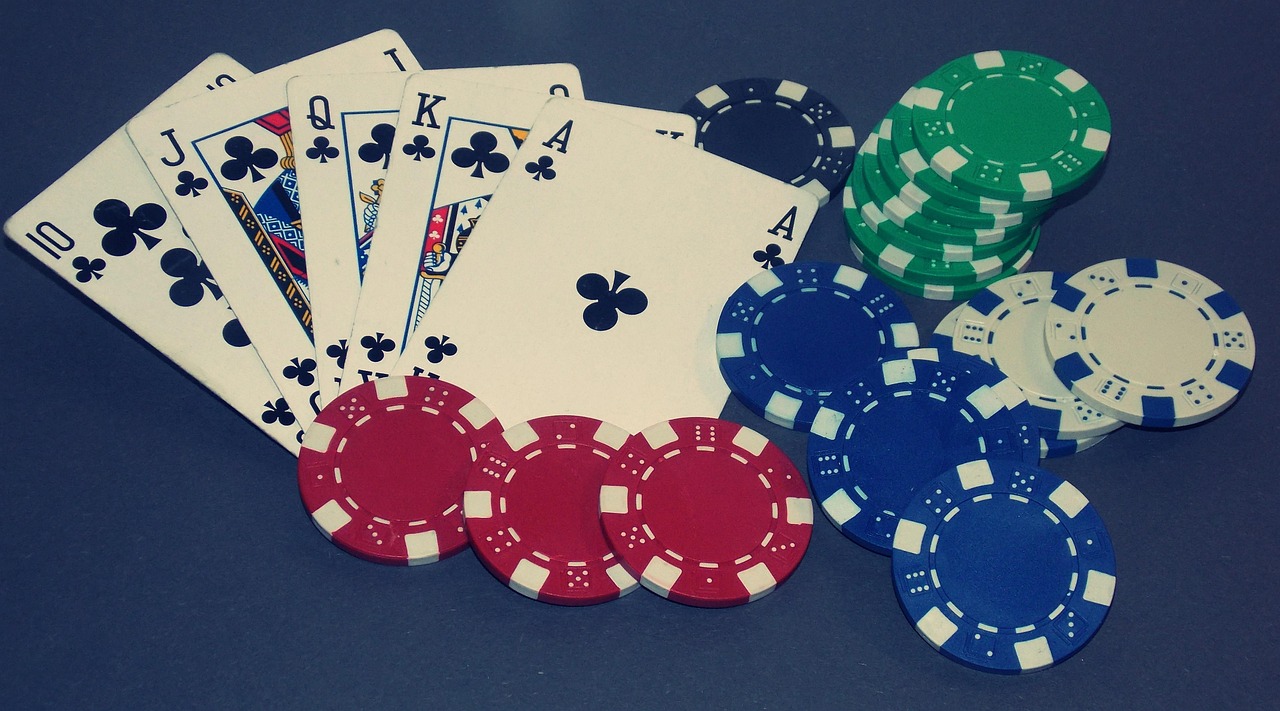
Okay, so let’s talk about the Fortune Bonus and the “Envy” side bet in Face Up Pai Gow Poker. These are optional bets that can add a little extra excitement to the game. Basically, you’re betting on getting a really good hand, and if someone else at the table gets a fantastic hand, you might win extra money just for being there!
The Fortune Bonus is a side bet where you’re wagering that your seven cards will form a qualifying poker hand. It’s separate from your main Pai Gow Poker wager, so you can win the bonus even if you lose the main hand. You place this bet in a special spot on the table before the cards are dealt. You gotta place a base bet in order to place a Fortune Bonus Bet. The bonus bet considers all seven cards you’re dealt, and if they make one of the hands on the payout table, you win!
Now, the “Envy” Bonus is where things get interesting. If you place a Fortune Bonus bet of a certain amount (usually $5 or more), you become eligible for the Envy Bonus. If another player at the table gets a really, really good hand (like a seven-card straight flush), and they also placed a qualifying Fortune Bonus bet, you win an Envy Bonus payout! You’re not eligible to win an Envy Bonus based on your own hand, only on other players’ hands. The dealer will rearrange the seven cards of the player to form the best possible hand for the purpose of the Fortune Bet Bonus Wager.
Here’s a quick rundown:
- Fortune Bonus: Bet on your own hand being good.
- Envy Bonus: Win if another player gets a super-good hand.
- Minimum bet: Usually $5 to qualify for the Envy Bonus.
It’s important to remember that the Fortune Bonus and Envy Bonus are completely separate from the main Pai Gow Poker game. You can win or lose either one independently of the other. They just add another layer of potential winnings (or losses) to the game.
So, if you’re looking to spice things up a bit, give the Fortune Bonus and Envy Bonus a try. Just remember to gamble responsibly!
11.Basic to Advanced Side Strategies
Okay, so you’ve got the basics of Face Up Pai Gow Poker down. Now, let’s talk about some strategies to maybe give you a little edge. It’s not all just luck, you know? There’s some thinking involved, especially when you start looking at the side bets.
First off, let’s be real: side bets are tempting. They offer the chance for a bigger payout, but they also increase the house edge. So, you gotta be smart about it. Don’t just throw money at them, hoping for the best. Think about the odds, think about your bankroll, and think about whether it’s actually worth the risk.
- Basic Strategy: Stick to the base game until you’re super comfortable. Get a feel for how the hands play out, how often you win, lose, or push. This is the most important thing.
- Fortune Bonus Strategy: If you’re gonna play the Fortune Bonus, understand the payouts. Some hands pay out big, but they’re rare. Look at the payout table and see if the potential reward is worth the risk, given how often those hands come up. The Fortune Bonus can be a fun addition, but don’t let it be a distraction.
12.What Makes Pai Gow Poker Unique
Pai Gow Poker definitely stands out from other casino games. It’s not just another version of poker; it’s a blend of Eastern and Western gaming traditions. The combination of strategy, luck, and the unique hand-setting element makes it a favorite for many players. Let’s explore what sets it apart.
- Blending Cultures: Pai Gow Poker merges elements of the ancient Chinese game of Pai Gow with the American game of Poker. This fusion creates a gaming experience unlike any other.
- Two Hands, One Goal: Unlike traditional poker, where you focus on a single hand, Pai Gow Poker requires you to create two separate hands – a five-card hand and a two-card hand. This adds a layer of complexity and strategic depth.
- House Way Option: If you’re unsure how to set your hands, you can ask the dealer to set them according to the “House Way.” This is a pre-defined strategy the casino uses, offering a safety net for new players.
The game’s pace is generally slower compared to other casino games. This allows players more time to think about their moves and enjoy the social aspect of the game. It’s less about rapid-fire decisions and more about calculated strategy.
- Joker’s Wild (Sometimes): The inclusion of a joker adds another twist. It can be used as an Ace or to complete a straight or flush, offering more flexibility in hand construction.
- Push Possibilities: A “push” (tie) is a common outcome in Pai Gow Poker. This reduces the volatility compared to games where you either win or lose, making it appealing to players who prefer a more balanced risk profile.
- Side Bets Galore: The availability of side bets like the Fortune Bonus and Envy Bonus adds excitement and potential for bigger payouts, even if your main hands don’t win.
Frequently Asked Questions
What exactly is Face Up Pai Gow Poker?
Face Up Pai Gow Poker is a fun card game you play at the casino. It’s like regular Pai Gow Poker, but with one big twist: the dealer’s cards are shown face up right from the start. This helps you make smarter choices about your own cards.
How is Face Up Pai Gow Poker different from the regular game?
The biggest difference is that you get to see the dealer’s cards before you decide how to set your own. Also, in this version, the casino usually doesn’t take a small fee (called a commission) from your winnings, and there’s a special rule about what happens if the dealer ends up with an ‘Ace-High’ hand.
How many cards do players receive in this game?
In Face Up Pai Gow Poker, both you and the dealer each get seven cards. These cards come from a special deck that has 53 cards in total: a standard 52-card deck plus one joker.
What’s the main idea or goal of playing Face Up Pai Gow Poker?
Your main goal is to beat the dealer. You do this by taking your seven cards and splitting them into two separate poker hands: one hand with five cards and another with two cards. Both of your hands need to be stronger than the dealer’s matching hands.
How do you set up or arrange your cards in Face Up Pai Gow Poker?
You take your seven cards and make two hands. One is your ‘high’ hand, which has five cards. The other is your ‘low’ hand, which has two cards. The most important rule to remember is that your five-card hand must always be better than your two-card hand.
What does the Joker card do in Face Up Pai Gow Poker?
The joker card in this game isn’t completely wild. It can be used as an Ace to help you form a strong hand. Or, if you’re trying to make a straight (cards in a row, like 3-4-5-6-7) or a flush (all cards of the same suit), the joker can fill in for any missing card to complete those specific hands.
Can you explain the ‘Ace-High Push’ rule?
This is a unique rule. If the dealer’s best five-card hand is an ‘Ace-High Pai Gow’ (meaning they don’t have any pairs or better, just an Ace as their highest card), then the game is a ‘push.’ A push means nobody wins or loses, and you get your original bet back.
Are there any extra bets I can make while playing?
Yes, you can often place extra bets, which are called side bets. Two common ones are the ‘Fortune Bonus’ bet, which gives you a payout if you get a really strong hand yourself, and the ‘Ace-High Bonus’ bet, which is related to the dealer’s hand.
Daniel Chase is a seasoned casino analyst and iGaming writer with over 10 years of experience in the online gambling industry. He specializes in game strategy, casino odds, and player-focused reviews. Daniel is passionate about helping players make smarter decisions through transparency, real data, and honest insight.
